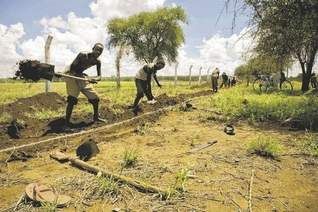I grew up in western Texas and covered the Midwest's devastating drought of 1988. I know what a drought looks like, but I've never seen anything like the devastation to a portion of the Rift Valley near the Tanzania border that I visited today in pursuit of corn farmers.
The savannah, where locals say the grass should be as much as two feet high, is barren save for scattered acacia trees and the many bones and other remains of cattle carcasses baking in the sun. Riccardo Gangale captured one such scene in the photo above. Maasai tribesmen, distinctive for the long poles they carry and their colorful wraps, usually bright red,
were herding along a road a few emaciated cattle that were barely recognizable as dairy cows. There, the cattle, ribs showing and udders shrunken, could forage in small patches of grass, barely an inch tall, that have grown where what rain that has fallen has pooled. It's the only green in sight.
On one Maasai family's farm 50 of 200 cattle died. Carcasses of the dead cattle are piled together while the farmers wait for them to dry enough to be burned. But these farmers are relatively well off. They had saved the rest of their 150 cattle by feeding them corn and hay, which is something any American farmer would do in the same circumstances. But in east Africa, that's not commonly done and for many poor farmers it's not even a realistic option. The cattle eat grass or nothing at all. And across great swaths of Kenya this year, there is simply no grass.
Farmers say they haven't had a good year of rainfall since 2005. Yet, in a regions like this many farmers persist in trying to grow corn and other crops. The farmers who can afford wells have some crops. That's how the Maasai family had the corn they needed to save most of their herd.
But then there are farmers such as 32-year-old Janet Kaindu, who relied on the faulty weather forecasts in October that predicted the El Nino effect would bring heavy rains across Kenya in November. She's now lost the second crop in a row on her three-acre plot.
There is a reason why corn grows so well in Iowa. There's plenty of water, and the soil is some of the best in the world, and farmers can afford to use the best seeds and plenty of fertilizer. Why do east Africans persist in growing corn in a place like this part of the Rift Valley? It's the crop they know, and it's what they want to eat.
